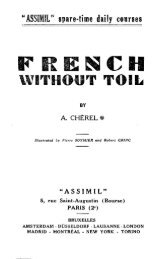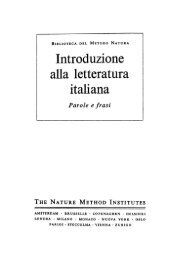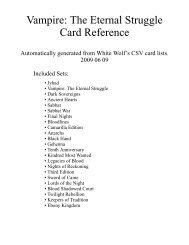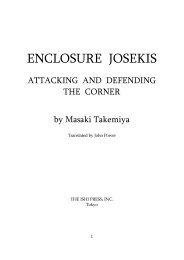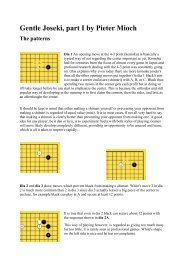Plains Cree: A Grammatical Study - Computer Science Club
Plains Cree: A Grammatical Study - Computer Science Club
Plains Cree: A Grammatical Study - Computer Science Club
Create successful ePaper yourself
Turn your PDF publications into a flip-book with our unique Google optimized e-Paper software.
28 [TRANS. AMER. PHIL. SOC.<br />
number-obviation paradigm and a few other suffixes<br />
(3.6, 3.7) form an outer layer of affixation.<br />
Nouns are of either gender, animate or inanimate.<br />
Simple noun stems end in a non-syllabic or a cluster<br />
of non-syllabics, e.g. maskisin- 'shoe,' ihkw- 'louse.'<br />
The usual citation form of nouns is not the stem but<br />
the inflected form for proximate singular which is<br />
identical with the stem except where the latter is<br />
monosyllabic; see 3.31.<br />
3.1. AFFIX POSITION CLASSES<br />
The position classes of the nominal affixes corre-<br />
spond closely, as far as applicable, to those of the<br />
verbal affixes; cf. 5.4. The present section may also<br />
serve as an index of morphemes.<br />
The prefixes are described in 2.1; but see also 3.22,<br />
especially for the indefinite possessor prefix mi-.<br />
The suffix position classes and their order are<br />
summarized below. The brief labels used in this<br />
list are intended as approximations only.<br />
1<br />
2<br />
3<br />
4<br />
5<br />
6<br />
possessive theme sign<br />
thematic obviative sign<br />
/epan/ 'former, absent'<br />
possessive person suffixes<br />
third person, locative, and vocative suffixes<br />
plural and obviation (animate) suffixes<br />
Suffix position 1 is occupied by the possessive theme<br />
sign /em/ (3.21).39<br />
The obviative sign of position 2, /eyi/, marks an<br />
obviative possessor (3.22).40<br />
The suffix /epan/ 'former, absent' is tentatively<br />
assigned to suffix position 3; see 3.5.<br />
In suffix position 4 there appear the personal<br />
suffixes of the possessive paradigm (3.22).<br />
In suffix position 5 there appear the third person<br />
suffixes of the number-obviation paradigm; the<br />
animate suffix is /wa/-/a/,<br />
WOLFART: PLAINS CREE<br />
the inanimate suffixes<br />
are /wi/-/i/ and /wah/-/ah/ (3.31).<br />
The locative (3.6) and vocative (3.7) markers are<br />
mutually exclusive with the morphemes of position<br />
5 and 6.<br />
In position 6 there appear the animate plural and<br />
obviative markers of the number-obviation paradigm,<br />
namely /k/ and /h/ (3.31).<br />
39 Note the homonymy of /em/ with the thematic obviative<br />
sign of verbs; cf. 5.41.<br />
40Although in a strict positional analysis positions 2 and 4<br />
might be merged, they are here kept apart for reasons of overall<br />
patterning; cf. 5.4 and 5.43.<br />
In eastern dialects the corresponding suffix marks the obviative<br />
in the number-obviation paradigm of inanimate nouns (see Ellis,<br />
1962: p. 3-20 and especially p. 8-13 for James Bay <strong>Cree</strong>; and also<br />
Rogers, 1960: pp. 110, 112 for the Mistassini dialect of Montagnais-Naskapi);<br />
however, since the data are incomplete and<br />
lack certain crucial examples (e.g., "he saw our canoe(s)" and<br />
"his son saw our canoe(s)") the relevance of this evidence cannot<br />
be assessed and the issue must be left open.<br />
3.2 THE POSSESSIVE PARADIGM<br />
The possessive paradigm provides anaphoric refer-<br />
ence to a person other than that denoted by the noun<br />
itself. Possession in a narrow sense is, of course, only<br />
the primary or focal meaning of this morpheme class<br />
(and the label "possessive" is chosen just because of<br />
its concreteness).4 Besides this narrowly possessive<br />
function, as in nitem 'my horse,' there are other, more<br />
attenuated meanings, as in ninehiyawewin 'my <strong>Cree</strong>-<br />
ness, my speaking <strong>Cree</strong>,' or in otocikaniwdw 'their<br />
doing'; (cf. the use of my in my mother or in my going to<br />
New York tomorrow).<br />
While certain noun stems show a special possessed<br />
theme (see 3.21), the possessive paradigm may occur<br />
with any noun stem. Conversely, however, some<br />
noun stems are obligatorily inflected for possession;<br />
these bound stems are called DEPENDENT noun stems.<br />
Dependent nouns mostly include kin terms, and terms<br />
for body-parts and a few personal possessions.42<br />
In general, the categories of the possessive paradigm<br />
are independent of those of the number-obviation<br />
paradigm. Thus, a stem inflected for a first person<br />
possessor may be either proximate, e.g. nisit 'my foot,'<br />
nisita 'my feet,' or obviative, as nitema in ndpew<br />
wdpamew nitema. 'The man sees my dog.' If the<br />
possessor is a third person, however, the usual rules<br />
of obviation operate. The possessor is always nearer<br />
(more in focus) than who or what is possessed, so that<br />
any third person possessor automatically causes the<br />
noun itself to be obviative.<br />
3.21. Theme Formation<br />
Possessed themes are formed with the theme sign<br />
/em/ which immediately follows the stem. However,<br />
the formation of possessed themes is subject to a<br />
great deal of irregularity which requires further study.<br />
The absence of the special theme sign is typical of<br />
stems ending in n (but is by no means restricted to<br />
these). It is found, for example, with a number of<br />
noun types derived from verbs, such as the abstract<br />
nouns of 6.41; e.g., nipimttisiwin 'my life,' otocikan<br />
'his doing, fault.' Possessive forms without special<br />
theme sign are also common with dependent stems,<br />
e.g., nistes 'my older sibling'; but contrast nisim<br />
'my younger sibling,' nitotem 'my kinsman,' etc.<br />
Other than that, the distribution of /em/ cannot<br />
even tentatively be indicated; the obvious hypothesis<br />
of an alienable: inalienable category has been explored<br />
without success. Examples: sSsip 'duck': nislsipim<br />
'my duck'; iskotew 'fire': nitiskotem 'my fire'; ihkw-<br />
'louse': nitihkom 'my louse'; etc.<br />
As an example of the seemingly erratic distribution<br />
of /em/ consider nitaskiy 'my country,' from askiy,<br />
in contrast to nipimsm 'my lard,' from pimiy.<br />
41 Hockett (e.g., 1966) uses the term "allocation."<br />
42 There is no evidence for an alienable: inalienable dichotomy.



